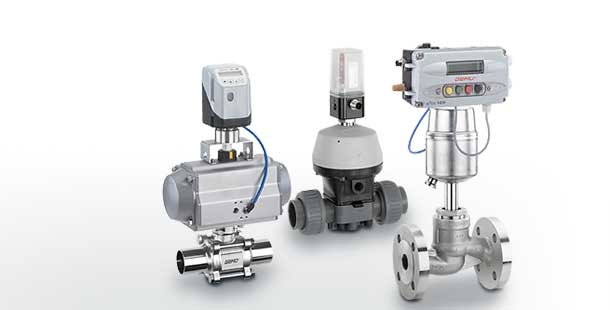Checking out the Functionality of Modern Control Valves in Industrial Applications
Checking out the Functionality of Modern Control Valves in Industrial Applications
Blog Article

Maximize Power Financial Savings and Convenience With Advanced Structure Automation Controls
In the realm of modern architecture and center monitoring, the combination of sophisticated building automation controls stands as a critical development. The convergence of modern technology and sustainability has actually birthed a new period where power effectiveness, comfort optimization, and operational streamlining are no more attainable realities but distant aspirations. By using the power of automation, structures can adapt, respond, and advance in methods that were once unbelievable. The potential for substantial energy savings and boosted comfort is not just a possibility yet a guarantee waiting to be fulfilled. This standard shift in structure administration holds the crucial to unlocking a globe where environmental conscientiousness and passenger wellness harmoniously exist side-by-side within the walls of our frameworks.
Energy Effectiveness Benefits
Energy efficiency advantages can significantly minimize power consumption and functional expenses in structures. Energy-efficient systems, such as innovative building automation controls, can enhance the usage of resources like heating, illumination, and air conditioning, leading to lower energy expenditures over time.
Furthermore, enhanced energy performance can extend the life-span of building equipment and systems. By running much more efficiently, HVAC systems, light, and other structure elements experience less damage, leading to decreased upkeep and substitute costs. In addition, energy-efficient structures usually command higher home values and rental rates, offering lasting economic advantages to proprietors.
Furthermore, energy efficiency can boost passenger comfort and performance. Correctly managed interior environments with ideal lighting and thermal problems develop a more conducive and pleasurable work area, leading to enhanced employee satisfaction and efficiency. Generally, the power effectiveness advantages connected with advanced structure automation controls are diverse, incorporating price financial savings, ecological stewardship, and owner well-being.
Improved Convenience Control
Enhancing convenience control in structure environments needs an advanced integration of sophisticated automation systems for optimum occupant health. By using innovative building automation controls, facilities can customize the indoor setting to fulfill the certain demands and choices of occupants. control valves.
By including these sophisticated controls, buildings can not just improve comfort yet likewise improve power effectiveness by maximizing system operations based on real tenancy and usage patterns. Ultimately, focusing on resident convenience via advanced automation systems leads to a much more pleasurable and much healthier interior environment.
Functional Performance Improvements

Moreover, the execution of real-time tracking and analytics devices allows structure operators to recognize energy inefficiencies and functional anomalies quickly. By continually monitoring power usage patterns and system performance metrics, adjustments can be made in real-time to maximize power usage and ensure peak functional effectiveness. control valves. Additionally, including need reaction strategies right into structure automation controls can even more boost operational efficiency by dynamically readjusting energy use based on grid conditions and prices signals
Indoor Environment Optimization
Efficient indoor environment optimization is a fundamental element of building automation controls, making sure owners' comfort and well-being while maximizing energy savings. By using advanced sensors and controls, constructing automation systems can continually change and keep track of temperature, humidity degrees, air top quality, and air flow to produce an ideal interior atmosphere. Preserving consistent and comfy conditions not just improves occupant contentment yet likewise enhances productivity and total health.
Interior climate optimization also plays an important role in power performance. By fine-tuning ventilation, cooling, and home heating systems based upon real-time data and tenancy patterns, constructing automation controls can dramatically minimize energy usage - control valves. Carrying out methods such as demand-controlled ventilation and thermal zoning can assist minimize energy waste while ensuring that each location of the structure gets the required conditioning.

Lasting Environment Production
Building automation regulates not just optimize indoor environment problems for energy efficiency and resident comfort yet additionally lay the structure for producing a sustainable atmosphere through tactical management of resources and systems. By integrating advanced structure automation technologies, such as sensors, actuators, and intelligent software program, facilities can keep track of and change power use in real-time to minimize waste and reduce their carbon footprint. These systems allow anticipating upkeep, recognizing potential issues before they intensify and optimizing equipment performance to improve durability and performance.
Additionally, lasting atmosphere development expands beyond energy monitoring to encompass water conservation, waste reduction, and interior air quality improvement. Structure automation controls can regulate water use, identify leakages, and guarantee proper garbage disposal methods, adding to general sustainability efforts. In addition, by monitoring and regulating ventilation and purification systems, these innovations enhance occupant wellness and performance while reducing power intake connected with HVAC operations.
Verdict
To conclude, advanced building automation manages deal significant benefits in terms of power financial savings, comfort control, operational effectiveness, indoor environment optimization, and developing a sustainable environment. By carrying out these controls, structures can attain optimal performance while decreasing energy usage and boosting owner convenience. It appears that making use of sophisticated automation modern technology is essential in improving structure efficiency and producing a much more lasting future.
Power performance advantages can significantly decrease energy consumption and operational costs in buildings. In general, the energy effectiveness benefits associated with advanced building automation controls are multifaceted, encompassing cost financial savings, environmental stewardship, and occupant well-being.
In addition, including need action methods into building automation controls can better boost functional effectiveness by dynamically changing energy use based on grid problems and prices signals.
Building automation regulates not only optimize find more information indoor environment problems for energy efficiency and occupant convenience but additionally lay the structure for producing a sustainable setting with strategic monitoring see page of resources and systems.In verdict, advanced structure automation manages deal substantial benefits in terms of power financial savings, comfort control, functional performance, indoor climate optimization, and developing a sustainable setting.
Report this page